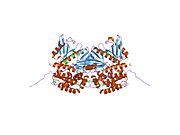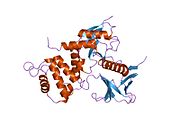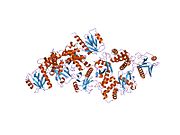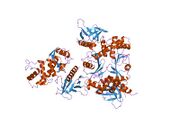Biology:Moesin
From HandWiki
Short description: Protein-coding gene in the species Homo sapiens
 Generic protein structure example |
Moesin is a protein that in humans is encoded by the MSN gene.[1][2]
Moesin (for membrane-organizing extension spike protein) is a member of the ERM protein family which includes ezrin and radixin. ERM proteins appear to function as cross-linkers between plasma membranes and actin-based cytoskeletons.[3]
Moesin is localized to filopodia and other membranous protrusions that are important for cell–cell recognition and signaling and for cell movement.[3]
Interactions
Moesin has been shown to interact with:
- CD43[4][5]
- ICAM3[6][7]
- Neutrophil cytosolic factor 1,[8]
- Neutrophil cytosolic factor 4[8]
- VCAM-1[9]
- EZR[10][11][12]
References
- ↑ "Moesin: a member of the protein 4.1-talin-ezrin family of proteins". Proc. Natl. Acad. Sci. U.S.A. 88 (19): 8297–301. Oct 1991. doi:10.1073/pnas.88.19.8297. PMID 1924289. Bibcode: 1991PNAS...88.8297L.
- ↑ "Subcellular localization of moesin in dynamic filopodia, retraction fibers, and other structures involved in substrate exploration, attachment, and cell-cell contacts". Exp. Cell Res. 219 (1): 180–96. Sep 1995. doi:10.1006/excr.1995.1218. PMID 7628534.
- ↑ 3.0 3.1 "Entrez Gene: MSN moesin". https://www.ncbi.nlm.nih.gov/sites/entrez?Db=gene&Cmd=ShowDetailView&TermToSearch=4478.
- ↑ "CD43 interacts with moesin and ezrin and regulates its redistribution to the uropods of T lymphocytes at the cell-cell contacts". Blood 91 (12): 4632–44. Jun 1998. doi:10.1182/blood.V91.12.4632. PMID 9616160.
- ↑ "Ezrin/radixin/moesin (ERM) proteins bind to a positively charged amino acid cluster in the juxta-membrane cytoplasmic domain of CD44, CD43, and ICAM-2". J. Cell Biol. 140 (4): 885–95. Feb 1998. doi:10.1083/jcb.140.4.885. PMID 9472040.
- ↑ "Moesin interacts with the cytoplasmic region of intercellular adhesion molecule-3 and is redistributed to the uropod of T lymphocytes during cell polarization". J. Cell Biol. 138 (6): 1409–23. Sep 1997. doi:10.1083/jcb.138.6.1409. PMID 9298994.
- ↑ "A novel serine-rich motif in the intercellular adhesion molecule 3 is critical for its ezrin/radixin/moesin-directed subcellular targeting". J. Biol. Chem. 277 (12): 10400–9. Mar 2002. doi:10.1074/jbc.M110694200. PMID 11784723.
- ↑ 8.0 8.1 "The NADPH oxidase components p47(phox) and p40(phox) bind to moesin through their PX domain". Biochem. Biophys. Res. Commun. 289 (2): 382–8. Nov 2001. doi:10.1006/bbrc.2001.5982. PMID 11716484.
- ↑ "Dynamic interaction of VCAM-1 and ICAM-1 with moesin and ezrin in a novel endothelial docking structure for adherent leukocytes". J. Cell Biol. 157 (7): 1233–45. Jun 2002. doi:10.1083/jcb.200112126. PMID 12082081.
- ↑ "Cytoskeleton-mediated death receptor and ligand concentration in lipid rafts forms apoptosis-promoting clusters in cancer chemotherapy". J. Biol. Chem. 280 (12): 11641–7. Mar 2005. doi:10.1074/jbc.M411781200. PMID 15659383.
- ↑ "Ezrin self-association involves binding of an N-terminal domain to a normally masked C-terminal domain that includes the F-actin binding site". Mol. Biol. Cell 6 (8): 1061–75. Aug 1995. doi:10.1091/mbc.6.8.1061. PMID 7579708.
- ↑ "Heterotypic and homotypic associations between ezrin and moesin, two putative membrane-cytoskeletal linking proteins". Proc. Natl. Acad. Sci. U.S.A. 90 (22): 10846–50. Nov 1993. doi:10.1073/pnas.90.22.10846. PMID 8248180. Bibcode: 1993PNAS...9010846G.
Further reading
- "ERM (ezrin/radixin/moesin) family: from cytoskeleton to signal transduction". Curr. Opin. Cell Biol. 9 (1): 70–5. 1997. doi:10.1016/S0955-0674(97)80154-8. PMID 9013673.
- "The ezrin protein family: membrane-cytoskeleton interactions and disease associations". Curr. Opin. Cell Biol. 9 (5): 659–66. 1997. doi:10.1016/S0955-0674(97)80119-6. PMID 9330869.
- "Human immunodeficiency virus (HIV)-1 proteins and cytoskeleton: partners in viral life and host cell death". Cell Death Differ. 12 (Suppl 1): 932–41. 2005. doi:10.1038/sj.cdd.4401582. PMID 15818415.
- "Ezrin self-association involves binding of an N-terminal domain to a normally masked C-terminal domain that includes the F-actin binding site". Mol. Biol. Cell 6 (8): 1061–75. 1995. doi:10.1091/mbc.6.8.1061. PMID 7579708.
- "Differential expression of the microspike-associated protein moesin in human tissues". Eur. J. Cell Biol. 67 (3): 189–98. 1995. PMID 7588875.
- "Physical association of moesin and CD46 as a receptor complex for measles virus". J. Virol. 69 (4): 2248–56. 1995. doi:10.1128/JVI.69.4.2248-2256.1995. PMID 7884872.
- "Structure and localization on the X chromosome of the gene coding for the human filopodial protein moesin (MSN)". Genomics 19 (2): 326–33. 1994. doi:10.1006/geno.1994.1065. PMID 8188263.
- "Heterotypic and homotypic associations between ezrin and moesin, two putative membrane-cytoskeletal linking proteins". Proc. Natl. Acad. Sci. U.S.A. 90 (22): 10846–50. 1993. doi:10.1073/pnas.90.22.10846. PMID 8248180. Bibcode: 1993PNAS...9010846G.
- "Moesin: a cell membrane protein linked with susceptibility to measles virus infection". Virology 198 (1): 265–74. 1994. doi:10.1006/viro.1994.1029. PMID 8259662. https://opus.bibliothek.uni-wuerzburg.de/frontdoor/index/index/docId/5873.
- "Phosphorylation of threonine 558 in the carboxyl-terminal actin-binding domain of moesin by thrombin activation of human platelets". J. Biol. Chem. 270 (52): 31377–85. 1995. doi:10.1074/jbc.270.52.31377. PMID 8537411.
- "Cytoskeletal proteins inside human immunodeficiency virus type 1 virions". J. Virol. 70 (11): 7734–43. 1996. doi:10.1128/JVI.70.11.7734-7743.1996. PMID 8892894.
- "Specific binding of HIV-1 envelope protein gp120 to the structural membrane proteins ezrin and moesin". Virus Res. 49 (2): 215–23. 1997. doi:10.1016/S0168-1702(97)00039-7. PMID 9213396.
- "Moesin interacts with the cytoplasmic region of intercellular adhesion molecule-3 and is redistributed to the uropod of T lymphocytes during cell polarization". J. Cell Biol. 138 (6): 1409–23. 1997. doi:10.1083/jcb.138.6.1409. PMID 9298994.
- "Identification of EBP50: A PDZ-containing phosphoprotein that associates with members of the ezrin-radixin-moesin family". J. Cell Biol. 139 (1): 169–79. 1997. doi:10.1083/jcb.139.1.169. PMID 9314537.
- "NHE-RF, a regulatory cofactor for Na(+)-H+ exchange, is a common interactor for merlin and ERM (MERM) proteins". J. Biol. Chem. 273 (3): 1273–6. 1998. doi:10.1074/jbc.273.3.1273. PMID 9430655.
- "Ezrin/radixin/moesin (ERM) proteins bind to a positively charged amino acid cluster in the juxta-membrane cytoplasmic domain of CD44, CD43, and ICAM-2". J. Cell Biol. 140 (4): 885–95. 1998. doi:10.1083/jcb.140.4.885. PMID 9472040.
This article incorporates text from the United States National Library of Medicine, which is in the public domain.
 |









